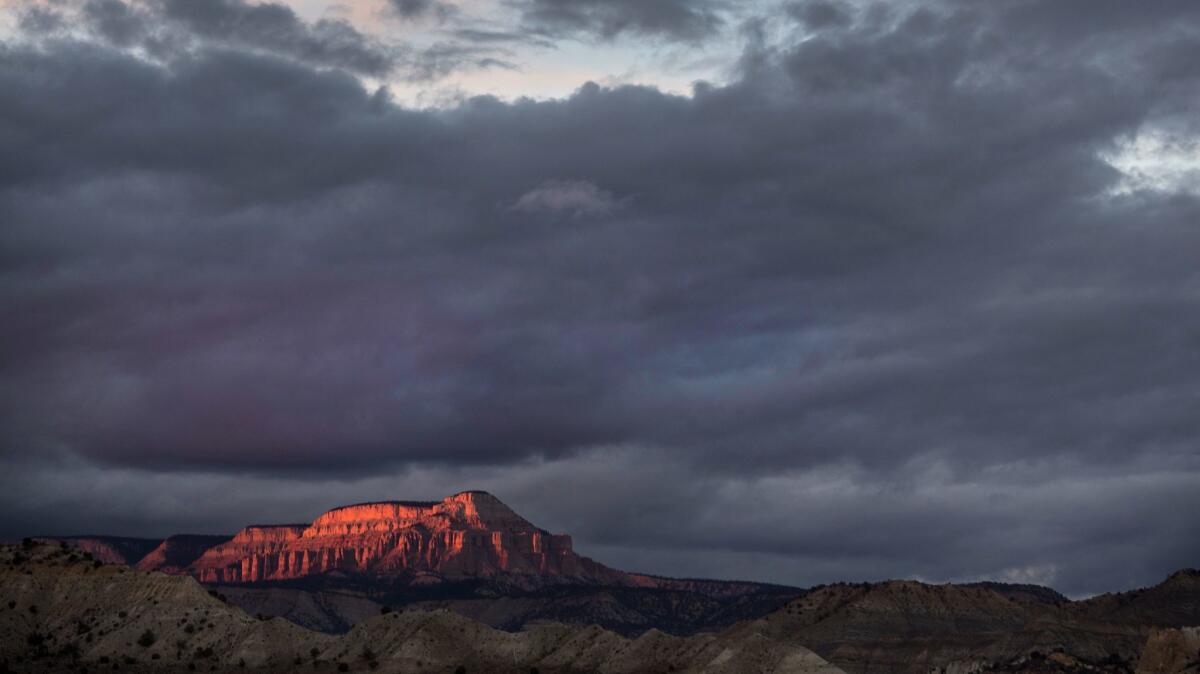Trump undercuts Obama and Clinton wilderness legacies in Utah. But is it legal?

President Trumpâs removal of federal protections from huge portions of two national monuments in southern Utah on Monday threatens to undercut the wilderness-conservation legacies of his Democratic predecessors Presidents Obama and Clinton.
Whether Trump has the legal authority to withdraw 1.1 million acres of land from Bears Ears National Monument and 800,000 acres from nearby Grand Staircase-Escalante will soon be tested in court.
Supporters of the monuments, which cover vast stretches of Utahâs scenic red-rock country, are preparing lawsuits to block Trump from shrinking them.
But Trumpâs drive to open wilderness to oil, gas, coal and mineral extraction, among other things, is already one of his most significant environmental legacies, along with his wholesale scrapping of Obama policies to address climate change.
How can a president unilaterally shrink a national monument?
The 1906 Antiquities Act empowers the president to establish national monuments by proclamation to protect landmarks and objects of historic or scientific interest. (Creation of a national park requires congressional approval.)
The naming of national monuments has become one of the most visible ways for presidents to establish a permanent legacy. Obama created Bears Ears in December 2016, a few weeks before the end of his presidency. Clinton named Grand Staircase-Escalante as a national monument in September 1996, seven weeks before his reelection.
The Antiquities Act says nothing about whether presidents have the power to revoke national monument designations of their predecessors.
Previous presidents have reduced the size of national monuments, but never on the scale that Trump did in Utah, and courts have never ruled on the legality of those cuts.
How much land did Trump withdraw from national monuments in Utah?
Bears Ears was 1.35 million acres. Trump sliced it into two national monuments totaling just under 229,000 acres.
Grand Staircase-Escalante was 1.9 million acres. Trump split it into three national monuments totaling just over 1 million acres.
Is it just scenic lands that could now be developed?
No. Much of the mesas, canyons and mountains of Bears Ears is sacred to Native American tribes, including the Navajo, Zuni, Ute Mountain and Hopi. Its archaeological treasures include rock art, ancient cliff dwellings and ceremonial sites.
Grand Staircase-Escalante is one of the worldâs premier sites for paleontological discoveries. More than two dozen new species of dinosaurs have been discovered there in the 21 years since Clinton preserved it as a national monument.
Fossils preserved from the Late Cretaceous period, from 100 million to 66 million years ago, have given scientists an unparalleled view of life on Earth in an era when the climate was hotter, the air contained a lot more carbon dioxide and the sea level was extremely high.
Do the boundary changes jeopardize any of the research?
The Society of Vertebrate Paleontology, a nonpartisan group of scientists, says the removal of national monument protections is a serious setback.
âTrumpâs claim that the new boundaries protect the resources named in the original proclamations is simply untrue,â said P. David Polly, an Indiana University professor who serves as the groupâs president.
âAlmost all of the Triassic period, the time when dinosaurs originated, has been purged from Grand Staircase-Escalante, as have the unique Cretaceous mammals and the amazing marine reptiles from the Tropic Shale that justified founding the monument in 1996.â
The shrinking of Bears Ears will cause similar damage to paleontology, he said.
Is Trump correct that citizens of Utah opposed the national monuments?
While many residents of Utah have long opposed federal control of public lands, opinion on the national monuments is split. Both monuments are major tourist attractions, stimulating the economy of towns nearby.
But political leaders in Utah have been nearly unanimous in opposing the national monuments, and they agree with Trump that some of his predecessors have abused their powers under the Antiquities Act.
âThank you for standing with the people of Utah,â Republican Sen. Mike Lee told Trump at the presidentâs announcement ceremony Monday in Salt Lake City.
A coal mine was going to open in Grand Staircase-Escalante when Clintonâs designation of the national monument put a stop to the project.
Rob Bishop, a Republican congressman from Utah, has proposed sharply curtailing the power of presidents to establish national monuments.
Âť
Twitter: @finneganLAT
ALSO:
Trump taking unprecedented action to revoke national monument designations in West
Trumpâs push to revive coal mining puts Utah dinosaur discoveries at risk, scientists say
Trumpâs environmental rollbacks hit California hard, despite Sacramentoâs resistance
More to Read
Sign up for Essential California
The most important California stories and recommendations in your inbox every morning.
You may occasionally receive promotional content from the Los Angeles Times.











